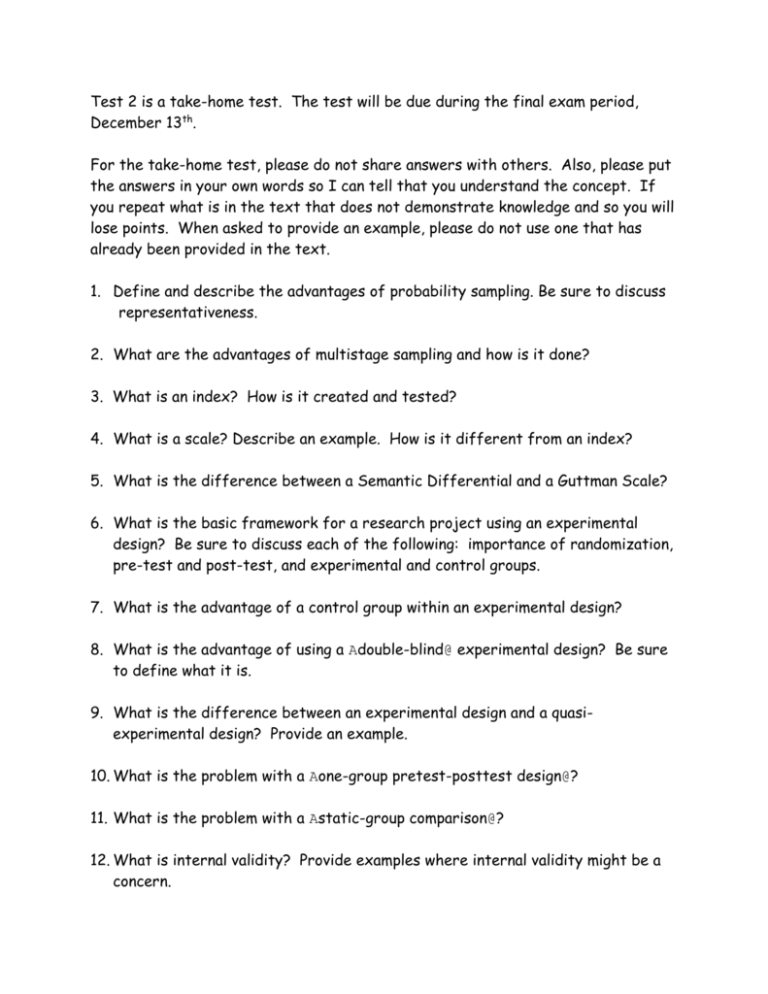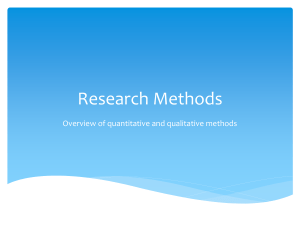Take Home Test 2
advertisement

Test 2 is a take-home test. The test will be due during the final exam period, December 13th. For the take-home test, please do not share answers with others. Also, please put the answers in your own words so I can tell that you understand the concept. If you repeat what is in the text that does not demonstrate knowledge and so you will lose points. When asked to provide an example, please do not use one that has already been provided in the text. 1. Define and describe the advantages of probability sampling. Be sure to discuss representativeness. 2. What are the advantages of multistage sampling and how is it done? 3. What is an index? How is it created and tested? 4. What is a scale? Describe an example. How is it different from an index? 5. What is the difference between a Semantic Differential and a Guttman Scale? 6. What is the basic framework for a research project using an experimental design? Be sure to discuss each of the following: importance of randomization, pre-test and post-test, and experimental and control groups. 7. What is the advantage of a control group within an experimental design? 8. What is the advantage of using a Adouble-blind@ experimental design? Be sure to define what it is. 9. What is the difference between an experimental design and a quasiexperimental design? Provide an example. 10. What is the problem with a Aone-group pretest-posttest design@? 11. What is the problem with a Astatic-group comparison@? 12. What is internal validity? Provide examples where internal validity might be a concern. 13. How does an experimental design address each of the following: historical events, maturation, effects of retesting, instrumentation, statistical regression, selection biases, experimental mortality? 14. What is external validity? Provide an example where external validity might be a concern. 15. What are the advantages of qualitative field research over quantitative research? What are the disadvantages? 16. Describe different roles of the observer and provide an example of each (please don=t use the same examples as used in the text). 17. There are different qualitative field research paradigms. One is descriptive, another attempts to identify the underlying assumptions of social behavior, and another attempts to generate theory. Describe each paradigm in more depth and provide an example of each. 18. How is the Aextended case method@ different rom the method of Agrounded theory@? 19. What is the difference between institutional ethnography and participatory action research? Give an example of each. 20. What steps should be taken when preparing to do field research? 21. How is a qualitative interview different from a structured interview? Describe the characteristics of a qualitative interview. In particular, what makes it effective? Please provide an example. 22. What is a focus group? When should it be used? What are its advantages? Provide an example. 23. What is group think and how is it related to focus groups? 24. What should be considered when recording observations? 25. Does field research provide more validity or reliability? Please explain. Be sure to define validity and reliability. 26. What is the difference between a case-oriented and variable-oriented approach to qualitative data analysis? 27. Describe the six different ways of looking for patterns in qualitative data. Provide an example for each. 28. What is the difference between semiotics and conversation analysis? Give an example of each and what might be considered when performing each. 29. How does Acoding@ fit within the process of qualitative research? What is it? Provide an example. 30. Define and provide an example of: memoing, concept mapping, NUD*IST. 31. What is unobtrusive research? Name and define three examples. Is it qualitative or quantitative research? Explain. 32. Provide an example of content analysis (shouldn=t be one from book). What is the unit of analysis? What is the sampling frame? How will you create your sample? Is it important that all units have an equal chance of being selected? Explain. What things will you count as you conduct the analysis? What is the advantage of using content analysis? 33. Babbie states that Acoding in content analysis involves the logic of conceptualization and operationalization@ (p.318). What does this mean? Why does coding involve these? 34. Provide an example (could be hypothetical) of secondary data analysis (shouldn=t be one from book). Who collected the data and what was the original purpose for collecting the data? What secondary analyses were done? What was the unit of analysis? Why might a validity problem exist and what could be done to address it? 35. Provide an example (could be hypothetical) of historical/comparative analysis (shouldn=t be one from book). Where did the data originate? What was done to check for bias? What questions were asked? How was the data analyzed? 36.Why are control group designs valuable to evaluation research? What is the advantage of the experimental design over the quasi-experimental design? 37. Why might it be difficult to specify the outcomes of a program to be evaluated? Why might it be difficult to operationalize success/failure? Provide an example. 38. Why might evaluation research results not be adhered to? Provide at least three reasons and an example of each. 39. Why is program evaluation more complicated than is often believed? Be sure to describe the different types of evaluations that can be done.











